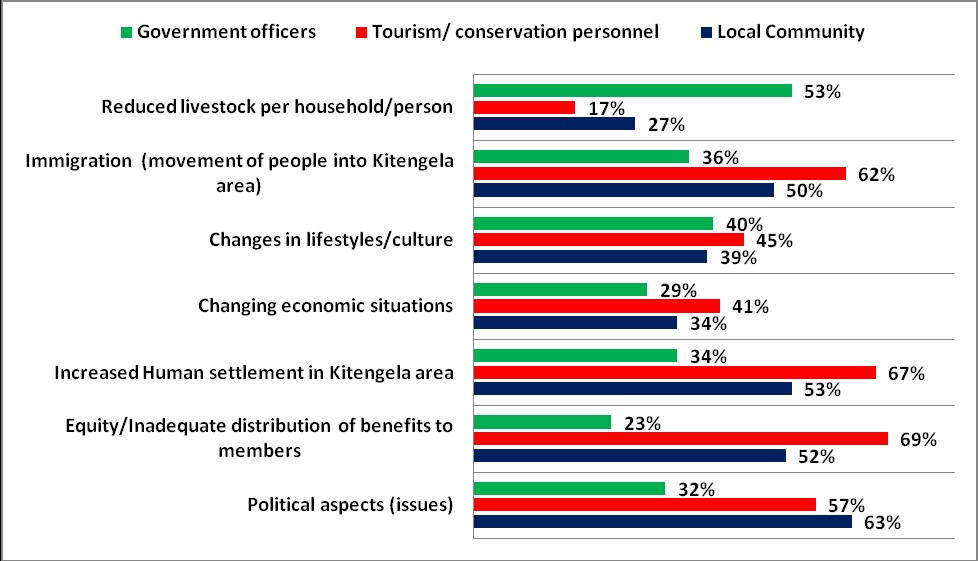Analysis of Impacts of Land Use Changes in Kitengela Conservation Area on Migratory Wildlife of Nairobi National Park, Kenya
Abstract
Nairobi National Park (NNP) in Kenya was established in 1946 to conserve the abundance and diversity of wildlife in the Kitengela-Athi-Kaputei plains, from excessive exploitation. It is currently fenced except on the Kitengela side across the Mbagathi River due to the sub-division of the group ranches, which commenced in the 1980s, limiting access of wildlife to the migratory corridor and dispersal areas. This paper is based on a study conducted to assess the impacts of the resultant land use changes in the Kitengela dispersal area/ migratory corridor on the migratory fauna of NNP, and to identify appropriate mitigation measures. The findings indicated that increased human settlement, led to changes in land uses which resulted into multiple negative impacts on the migratory wildlife of Nairobi National Park, mainly due to loss of dispersal area and blockage of migratory routes, leading to wildlife confinement, decreased wildlife tolerance and increased incidences of human wildlife conflicts. Data analysis indicated decline in migratory wildlife population thus negative effect (F=, 6.066, p<0.05). The findings also indicated that loss of migratory routes/dispersal area and reduced vegetation cover was regarded by 55% of the local community respondents as one of the main consequences of the land use changes resulting from the subdivision of the group ranches leading to decreased wildlife tolerance (β = 0.246) and wildlife confinement (β = 0.371) in NNP (p= 0.021, < 0.05, F= 2.678; R=0.179, R2= 0.032). The paper also discusses the mitigation measures for the longtime sustainability of the park, the dispersal area and migratory corridor, including holistic implementation of the Kitengela-Isinya-Kipeto Local Physical Development Plan, mapping and protection of the vital wildlife areas within the migratory range, including the wildebeest calving area in North Kaputiei.
References
Cheeseman, T. (2002). Conservation and the Maasai in Kenya: Trade-offs or lost mutualism? Policy Failure in Kenyan Conservation and Maasailands. Cheeseman Ecological Safaris. Retrieved September 4, 2016 from http://www.environmentalaction.net/kenya/kenya_policy failure.html
Colorado State University (United States of America). (2012). Retrieved September 22, 2016, from http://www.nrel.colostate.eduprojects gnu/imageStudy_Area.png
East African Wildlife Society (EAWLS). (2002). A Survey to determine the availability of land for wildlife migration in the areas bordering Nairobi National Park, EAWLS, Nairobi.
Fischer, A., Laing, J., & Stoeckel, J. (1983). Guidelines for Overcoming Design Problems in Family Planning Operations Research. Mediline, 16(2), 100-105. https://doi.org/10.2307/1965575
Food and Agricultural Organization (FAO) Retrieved October, 1, 2015from http://www.fao.org//y4307e05.htm
Galaty, J. (1999). Grounding pastoralists: Law, politics and dispossession in East Africa. Nomadic Peoples, 3(2), 56-73. https://doi.org/10.3167/082279499782409334
Gichohi, H. (1996). The Ecology of a truncated ecosystem: The Athi-Kapiti Plains, PhD Thesis, University of Leicester, Leicester, United Kingdom.
Government of Kenya (GoK). (2001). Population and housing census, vol.1.Counting our people for development. Population distribution by administrative areas and urban centres. Ministry of Finance and Planning. Nairobi, Kenya, 446pp.
Homewood, K. (Ed.). (2005). Rural resources and Local livelihoods in Africa. James Currey, Oxford and Palgrave. https://doi.org/10.1007/978-1-137-06615-2
Homewood, K., Kristjanson, P., &Trench, P. C. (2009). Changing land use, livelihoods and wildlife conservation in Maasailand. In Homewood, K., Kristjanson, P., & Trench, P. C. (Eds). (2009). Staying Maasai? Livelihoods, Conservation and Development in East African Rangelands, Springer Science + Business Media, New York. https://doi.org/10.1007/978-0-387-87492-0_1
Igoe, J. (2007). Human rights, conservation and the privatization of sovereignty in Africa- A discussion of recent changes in Tanzania. Policy Matters, 15, 241-254.
Kaasha, J. M. (2001). Ecotourism micro-enterprises a tool to conserve natural resources. Paper presented in the Micro and small enterprise development and associated natural resource use workshop, 21st - 22nd February, 2001, International Council for Research in Agroforestry (ICRAF), Nairobi.
Kenya Wildlife Service (KWS). (1996). Wildlife human conflicts - Executive Summary. SAFARIWEB, Inter Green Services Limited, KWS, Nairobi. (Accessed 31st May, 2006).
Ministry of Environment and Natural Resources (MENR). (1994). National Environnemental Action Plan (NEAP), National Environment Secretariat, Nairobi.
Ministry of Lands. (2010). Kitengela-Isinya-Kipeto Local Physical Development Plan,2008-2018, Ministry of Lands (Department of Physical Planning), Nairobi.
Morell, V. (1996). Surrounded! - Civilization is encroaching on Nairobi National Park in Kenya- Nairobi's Wild Side. International Wildlife, 27(4), 38-44.
Mugenda, O. M., & Mugenda, A. G. (2003). Research methods - Quantitative and qualitative approaches, ACTS Press, Nairobi.
Mungai, N. (2003). Nairobi National Park threatened by human-wildlife conflicts. Retroieved May 31, 2010, from http://www.ens-newswire.com/ens/mar2003
Muriithi, P. I. (2008). Human wildlife conflicts: A case study of peoples’ participation in conflict resolution. Master of Arts in Sociology (Rural Sociology and Community Development) Thesis, University of Nairobi.
Mwangi, E. (2007a). Socio-economic change and land use in Africa: The transformation of property rights in Kenya’s Maasailand. Macmillan, Palgrave. https://doi.org/10.1007/978-1-137-06659-6_8
Mwangi, E. (2007b). The Puzzle of group ranch sub-division in Maasailand. Development and Change, 38(5), 889-910. https://doi.org/10.1111/j.1467-7660.2007.00438.x
Mwangi, E. (2007c). Sub-dividing the commons: Distributional conflict in the transition from collective to individual property rights in Kenya’s Maasailand. World Development, 35(5), 815-834. https://doi.org/10.1016/j.worlddev.2006.09.012
Nkedianye, D. (2004). Testing the attitudinal impact of a conservation tool outside a protected area: A case study of Kitengela Wildlife Consolation Lease Programme for Nairobi National Park, Kenya. Master of Arts (Rural Sociology and Community Development) Thesis, University of Nairobi.
Nkedianye, D., Radeny, M., Kristjanson, P., & Herrero M. (2009). Assessing Returns to Land and Changing Livelihood Strategies in Kitengela, in Homewood, K; Kristjanson, P., & Trench, P.C.(Eds); Staying Maasai? Livelihoods, Conservation and Development in East African Rangelands (p.128), Springer Science and Business Media, New York. https://doi.org/10.1007/978-0-387-87492-0_4
Nyeki, D. M. (1992). Wildlife conservation and tourism in Kenya. Jacaranda Designs, Nairobi
Odongo, P. (2012). Outrage as morans kill six lions in night of terror, Daily Nation, Thursday, 21st June, 2012, Nation Media Group, Nairobi, Kenya
Ouko, E., & Marekia, N. (1996). Land tenure and wildlife management, in Juma, C. & Ojwang, J. (eds.), In Land We Trust, Initiatives Publishers, Nairobi.
Porteous, J. D., & Smith, S. E. (2001). Domicile: The global destruction of home. McGill-Queen's Press. Retrieved September 25, 2016, from http://books.google.ie/books?id=6t_KSirfEnsC&dq
Prins, H., Grootenhuis J. G., & Dolan T. T. (2000) (Eds). Wildlife conservation by sustainable use. Kluwer Academic Press, Boston. https://doi.org/10.1007/978-94-011-4012-6
Regional Centre for Mapping of Resources for Development (RCMRD). (2013). Satellite Images of Kitengela Area. RCMRD, Nairobi.
Reid, R., Gichohi, H., Said, M. Y., Nkedianye, D., Ogutu, J., Kshatriya, M., Kristjanson, P., Kifugo, S., Agatsiva, J., Adanje, S., & Bagine, R., (2008). In K.A. Gavin, N.T. Hobbs, R. Behnke& R. S. Reid, (eds.). Fragmentation of Arid and semi-arid lands. Kluwer Academic Press, London.
Reto-o-Reto. (2009a). Kitengela, Policy Brief No. 1, Reto-o-Reto, Nairobi
Reto-o-Reto. (2009b). Kitengela transforming: Will pastoralists and wildlife survive? Policy Brief No.2, Reto-o-Reto. Nairobi.
Rutten, M. M. (1992). Selling wealth to buy poverty: The process of individualization of land ownership among the Maasai pastoralists of Kajiado District, Kenya, 1890-1990.VerlagBreitenbach Publishers, Fort Lauderdale, FL.
Waithaka, J. (2004). Maasai Mara-An ecosystem under siege: An African case study on the societal dimension of range and forage science. African Journal of Ecology: The Official Journal of the Grassland Society of Southern Africa, 21(2), 79. https://doi.org/10.2989/10220110409485838
Wandaka, J. K. M. (2006). Opportunities and challenges to effective community participation in ecotourism management in Kimana Communal Ranch, Kajiado District, Kenya, Masters of Environmental Studies (Science) Thesis, Kenyatta University, Nairobi.
Wandaka, J. K. M. (2012). Effective community participation in ecotourism management: opportunities and challenges in African rangelands. Lambert Academic Publishers, Saarbruk, Germany.
Wandaka, J. K. M. (2018). Human Wildlife Conflicts in Kenyan Rangelands, Lambert Academic Publishers, Saarbruk, Germany
Western, D. (1969). Land use in Maasai Amboseli Game Reserve: A case study; The Inter-Disciplinary Cooperation Institute for Development Studies Research Bulletin, No. 40; Institute for Development Studies, University of Nairobi, Nairobi.
Western, D. (2009). The future of Maasailand: its peoples and wildlife; in Homewood, K., Kristjanson, P., & Trench, P. C. (Eds.). (2009). Staying Maasai? Livelihoods, Conservation and Development in East African Rangelands, Springer Science and Business Media, New York.


This work is licensed under a Creative Commons Attribution 4.0 International License.
Copyright for this article is retained by the author(s), with first publication rights granted to the journal.
This is an open-access article distributed under the terms and conditions of the Creative Commons Attribution license (http://creativecommons.org/licenses/by/4.0/).








1.png)














